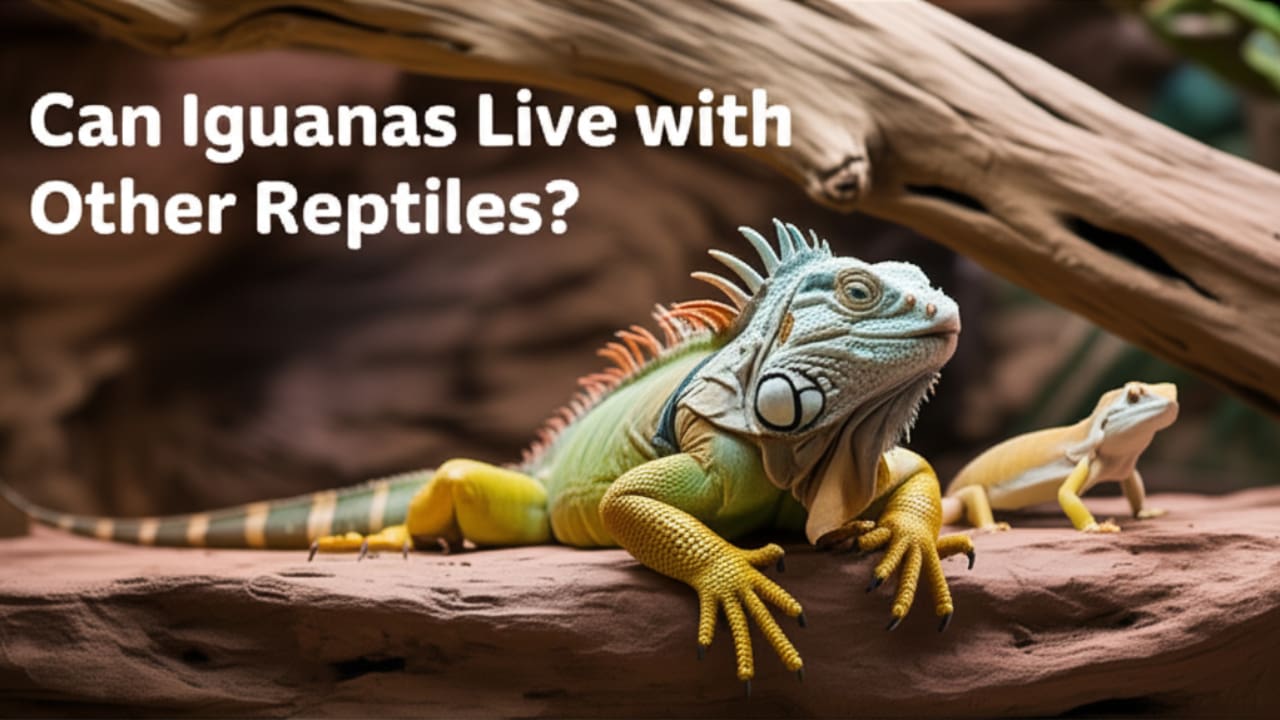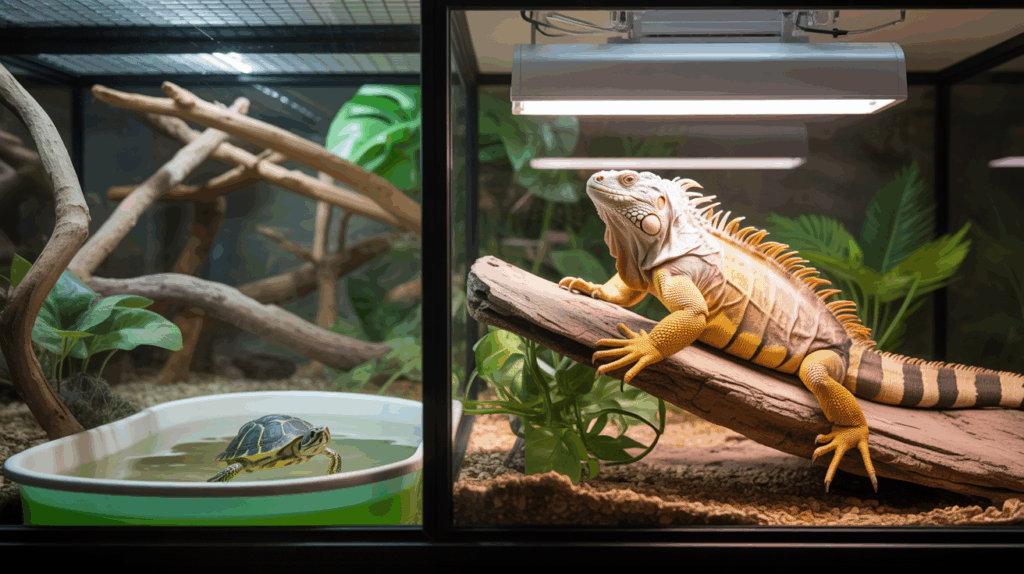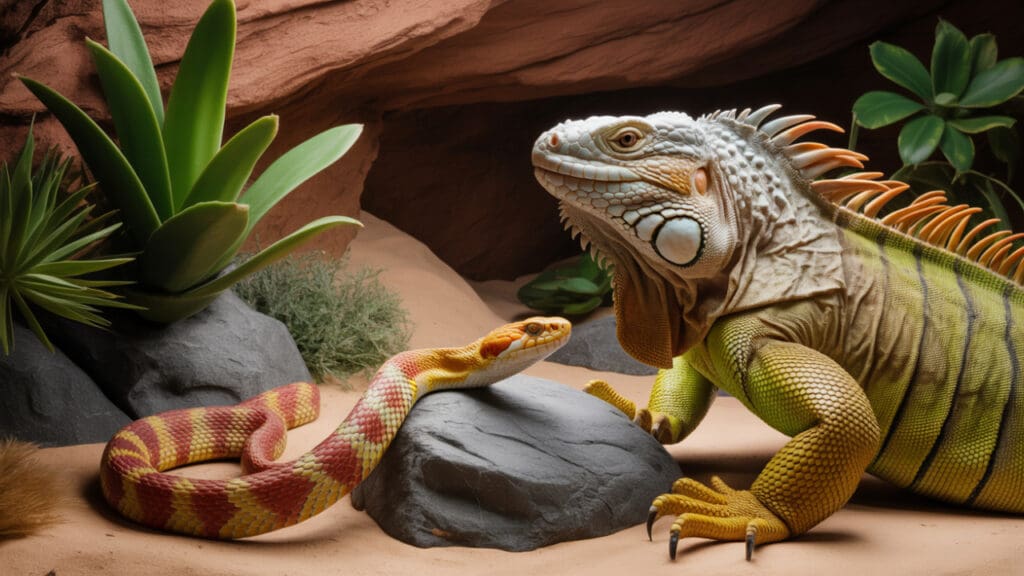
Newsletter Subscribe
Enter your email address below and subscribe to our newsletter

Enter your email address below and subscribe to our newsletter

You’ve made the purchase for your second reptile. In your head, you could imagine the iguana you have at home loving their new companion. But all you had seen for the next few days was your little guy lashing out with tail whips and bites.
Do they need more time getting acquainted? Actually, can iguanas live with other reptiles to begin with? These are not the questions you want to ask after introducing the second pet.
Now, your iguana is solitary by nature, so they can rarely tolerate other reptiles. It’s less about how large or elaborate your setup is. Your reptile friend is fiercely territorial. So, they are easily stressed out by cohabitation, and this can snowball into issues such as suppressed immunity and other costly health problems.
Many of us may think that our iguana gets lonely when they are kept alone. However, the truth is that these reptiles are not like some others out there. They thrive in solitude and do not appreciate having companions.
In this article, you will see how mixing species can lead to serious risks like cross-contamination of parasites and respiratory infections. These issues usually require hundreds of dollars in treatment, so be warned.
We’ll also look into the common mistakes you can avoid as an iguana parent. By the end, you should know how to safeguard your reptile companion’s welfare and align your decisions with expert guidance.

Yes, your iguana does look docile in their enclosure. But instincts ultimately drive their behavior. Your little companion is naturally solitary and territorial. So, they will defend basking spots and food sources from others of their kind.
Understand that when you introduce a second reptile into their home, your iguana doesn’t see them as a potential “roommate.” Instead, they view the intruder as a competitor. Your male iguana, especially, can become extremely territorial during breeding season. And the female can be just as aggressive if their personal space is invaded.
Exotic animal vets say that having a bigger cage often doesn’t solve the problem. The issue is more biologically ingrained than space management. Tail whips, bites, and long-term stress injuries are some of the things you’ll see if you intend to force a roommate on your iguana.
Remember, cohabitation leads to stress for your reptile companion. And stress can compromise their health, reducing their appetite, suppressing their immune function, or even stunting growth. In turn, you’ll also see the financial stress of having to treat these stress-related illnesses or infections. So, learn to prevent rather than having to fix the problem later.
Experts usually recommend a “single housing rule” for our iguana. Your little friend can’t even tolerate their siblings that are raised together sometimes, let alone a stranger. So, let’s respect our iguana’s natural behavior and instincts to keep them thriving.

Now, if you’d like to give that rare possibility of cohabitation a chance, then the first thing you should look into is the environment. That said, know that most reptiles have different environmental needs. So, it’s unlikely that two different species can be perfectly compatible.
In comparison, bearded dragons are desert reptiles that thrive in drier climates. Tortoises, on the other hand, prefer different humidity gradients altogether. It’s quite the challenge keeping two different species in the same enclosure.
Building a massive, climate-controlled habitat can cost a staggering amount of money. Customizing the enclosure with dual heat and humidity zones is no small feat and requires much care. If it’s not done right, it could lead to your animals developing issues like respiratory issues, metabolic bone disease, or other infections.
What about the same species? How many iguanas can live together in the same setup? Well, even keeping two of them together is a challenge. It’s true that environmental needs are not much of a concern. But iguanas fight with each other for basking spots and food sources regardless of how much space there is.

Sure, you can take the risk, but it’ll definitely be a challenge to house two different reptiles in one enclosure. Your iguana is not naturally social, so they are not compatible with most animals out there.
Let’s start with small animals. You may find that small species of geckos and anoles, for example, have a higher chance of surviving in the same environment as your iguana. But understand that the risk of injury is very high. It could be accidental or intentional, but your iguana may harm the small animals with their powerful tail whips or bites.
Tortoises do share a vegetarian diet with your iguana. But not that their humidity and temperature needs aren’t exactly the same. These herbivores can also compete for food and basking space. Additionally, tortoises might carry parasites that could harm your iguana.
Bearded dragons are popular, hardy reptile pets. However, they need a different environment from what your iguana needs. A bearded dragon thrives in dry and arid conditions. Your iguana, on the other hand, requires high humidity. It’s extremely difficult to find a balance.
There may be a few people thinking that a large reptile might work with their iguana. But make no mistake. Your iguana is probably food for the snake. So, it’s best not to risk it.
It may seem like a practical idea. After all, you don’t need to concern yourself with different habitat issues. And it might be great to introduce a companion to your iguana, like how small mammals and birds crave companionship.
Remember that your little reptile friend is solitary by nature. So, can iguanas live together in the same enclosure without conflict? It’s rare (not impossible), and hardly ever without problems.
Let’s take a closer look. If you raise them from a young age together, your iguanas may seem like they tolerate each other in the beginning. But as they mature, their territorial instincts surface.
You can often see male iguanas being a lot more aggressive. They will defend the basking areas and food, using their powerful tail to strike others and even bite them. Females may not be as aggressive. But do lash out when the space feels limited.
Note that competition between your iguanas is likely to persist. And you might see frequent bite wounds, broken tails, or stress-related illness. The cost of treatment can be quite hard on your finances. So, experts usually advise against group housing. The risks outweigh what you might see as benefits.
Perhaps the idea of having a mixed reptile enclosure still appeals to you. Maybe you just like seeing your iguana in the same space with a turtle or some small lizards.
The most obvious risk of housing two separate species of reptile is physical aggression. Your iguana has a powerful tail. And it’s capable of using it to whip with surprising force. Their sharp claws and strong jaws are not to be underestimated as well. Smaller reptiles can easily be injured or even killed in no time.
On the other hand, bigger reptiles, like boas or monitors, may see your iguana as prey. That puts your little one directly in the face of danger. Even if these larger reptiles aren’t out to eat your iguana, they are still likely going to compete for food with them. This leads to stress for all parties, and illnesses follow.
The next thing is disease transmission. You should know that different reptiles can carry unique parasites, bacteria, or fungal infections. Tortoises can house intestinal parasites that may not affect them much. But these parasites can cause digestive illness in your iguana.
Another example is bearded dragons. These reptiles are prone to respiratory infections that can spread in the high-humidity conditions your iguana needs to live in. You’ll be seeing a lot more money spent on treatment then.
In short, it’s not exactly impossible to house two reptiles in the same enclosure. But your initial attempt at species mixing can end up being way more expensive than simply providing separate enclosures.
Trying to keep two iguanas together may sound cheaper, but in reality, it almost always costs more-both financially and in terms of animal welfare. Here’s a clear breakdown:
| Expense Category | Solo Iguana Setup (Recommended) | Failed Cohabitation Setup |
| Initial Enclosure | $500–$1,000 (Custom 8x6x4 ft habitat) | $1,200–$2,500+ (Extra-large, multi-zone enclosure) |
| Annual Utilities | $200–$400 (Heat & UVB lighting) | $500–$800+ (Two full heating/lighting systems) |
| Emergency Vet Visit | $135–$200 (Routine check-up) | $500–$1,500+ (Injury treatment, infections from fighting) |
| Long-Term Medication | Rarely needed | $100–$300/month (Antibiotics, antiparasitics after injuries) |
| Total Year 1 Cost | $700–$1,400 | $2,300–$5,100+ |
| Animal Welfare | High (One iguana thriving) | Critically Low (Stress, injuries, poor health) |
A single iguana in the right setup thrives and costs less long-term. Two iguanas housed together usually end up fighting, getting sick, and creating massive medical bills.
Let’s take a look at some misconceptions or myths regarding iguana cohabitation. You might think that it’s a romantic idea to have a few species living in the same space with your iguana in the lush habitat. But that’s not as easy to achieve.
Possibly, the most widespread misconception is that your iguana can get lonely if it’s housed alone. Like what we’ve mentioned, your reptile friend is solitary and does not seek companionship. They are best left alone in their own space. And you’ll often find two iguanas living together, fighting each other.
Another myth closely linked to this is that iguanas can live together, depending on the size of the habitat. Just because your cage is larger, it really doesn’t solve the problem of your reptiles fighting for food and their favorite spot. Their territorial instincts are very much hardwired.
Can 2 iguanas live together? That’s a question turned assumption that most people have, too. Juvenile iguanas may be fine living together. But maturity soon triggers their territorial dominance. So, don’t go assuming that your reptile pets see each other as brothers.
Cohabitation is usually not worth the risk. It’s probably best to buy an extra enclosure rather than to watch your reptiles tear each other apart, just for you to spend more on treatment.
Now that we’ve seen how cohabitation might not be ideal, let’s check out the right environment, specifically for your iguana. You’ll need to target certain issues in order to keep your reptile healthy and thriving.
First off, you should keep in mind that size does matter. Your iguana can reach five to six feet in length upon hitting adulthood. That means their enclosure should be at least 10’L x 5’W x 6’H, or 3 x 1.5 x 1.8m to provide them with ample space.
You may be one of those who is planning on starting with a smaller cage and thinks you’ll upgrade later. Be warned. Cramped space can lead to stunted growth and weakened immunity. You might even see some behavioral issues in your iguana that can be difficult to reverse.
Next, you should focus on environmental control. Your iguana needs a basking temperature of between 95–100°F and an ambient zone of around 80–85°F. Also, you should maintain the humidity level at 60–70%. Otherwise, you might see issues like respiratory infections or metabolic bone disease in your iguana.
Reptile vets say that we need to replace the UVB bulbs every six to twelve months. This is a non-negotiable commitment. You can expect to spend about $30–50 for a quality bulb. It might seem expensive. But compare this with vet bills that can easily exceed $500, and consider your pet’s health.
You should understand that your exotic pet or pets are reliant on you to provide them with a safe and healthy environment. Enclosure size, heating systems, and food are definitely important. But you also need to consider the ethical responsibility as a pet parent.
A big ethical concern in the discussion of reptile ownership is chronic stress. As you know, reptiles do not make noises of discomfort like cats and dogs do. Their signs are a lot more subtle in the form of reduced appetite, dull coloration, or lethargy. It’s invisible suffering, basically. And vets say that this can shorten an iguana’s lifespan by years.
Cohabitation contributes to such stress for your iguana, as they deny your reptile friend the solitary time they need, their natural behavior. It’s essentially sacrificing their freedom for constant competitions. And let’s not forget about the issues with injuries and illnesses.
Cost will come into play as well after that. Think parasite transmission, tail injuries, and territorial fights. You’ll need to fork up hundreds in vet bills. Yet, no amount of damage can completely reverse the damage done if it’s chronic.
In short, respect your iguana’s solitary and natural behavior. Try to avoid introducing a “housemate” for the sake of aesthetics. Your animal’s welfare should be prioritized over your friend’s impressed look.
When it comes to keeping your iguana, you’ve probably asked many questions about housing, compatibility, and safety. Let’s check out some of the most frequently asked questions about iguana cohabitation. Each answer is grounded in expert advice and practical care considerations.
It’s best to keep your iguana alone. Some small reptiles or amphibians might survive in the same space as your iguana for a while. But there’s always a risk of stress, injury, or disease.
No, their environmental needs are completely different. Bearded dragons prefer dry, arid habitats. Your iguana, on the other hand, likes high humidity. So, they are quite incompatible as tank mates.
Iguanas are very territorial. So, keeping them together will likely result in fights, injuries, and chronic stress. Unfortunately, there’s no exception even if they were raised together since young.
Although both are herbivores, tortoises and iguanas need different humidity levels and temperatures to thrive. They may also carry parasites that could harm one another. So, it’s best not to share an enclosure.
Your iguana can become defensive, aggressive, or stressed when a “roommate” is introduced. This stress can suppress their immune systems. And that means more money for treatment.
In the wild, iguanas naturally defend their food sources, basking areas, and mates. These instincts remain strong in captivity. So, they are prone to aggressive behaviors when they share a space with other animals.
They may fight for dominance. You might see tail whips, bites, or even life-threatening injuries. Considering the vet bills, it’s cheaper to just keep the two separate in the long run.
Even in oversized enclosures, iguanas will usually continue to compete for territory and resources. The size of the cage does not remove their instinct to dominate.
No. Your iguana is a solitary reptile. They thrive independently and do not need companionship in order to feel secure or healthy.
If you mix species, you’ll likely see challenges that involve predation, increased stress, and disease transmission. These usually lead to injury or death. That’s why vets universally discourage mixing iguanas with other animals.
You don’t need to put two iguanas in the same enclosure to enjoy having more than one. With the right setup, each iguana can live happily on its own while you still enjoy a multi-reptile home.
Spend time with each iguana separately, outside of their cages. This helps you:
If cages are in the same room, add solid dividers so iguanas can’t see each other. Iguanas don’t need company to feel secure. In fact, seeing another iguana often causes stress and territorial behavior.
A busy iguana is a happy iguana. Replace social interaction with enrichment, such as:
Keep each enclosure in a separate part of the room. This lets you enjoy multiple iguanas at once without the risks of fighting, stress, or poor health.
Can iguanas live with other reptiles? No. The bottom line is quite clear. Your reptile field is a solitary animal, so they don’t need to have a playmate. Keeping your iguana with other reptiles will almost certainly lead to stress, aggression, or costly health issues.
You might think that the idea of cohabitation is appealing, but only in an ideal world. The risks of keeping two iguanas together are just riskier than it’s worth. And you most definitely wouldn’t want to spend extra cash on emergency vet visits.
Make the smart decision, which is both ethical and cost-effective. And that is to keep your iguanas separate. Provide a house for each of them, a personal, dedicated enclosure. You’ll save yourself lots of problems in the long run.
So, apply what you’ve learned and get yourself two setups (or more) for your little reptile friends. They will thrive and stay safe in the stress-free environments you’re creating for them.
Have you tried keeping an iguana with another reptile? Did it go smoothly? Did something go wrong? Let us know in the comments down below!